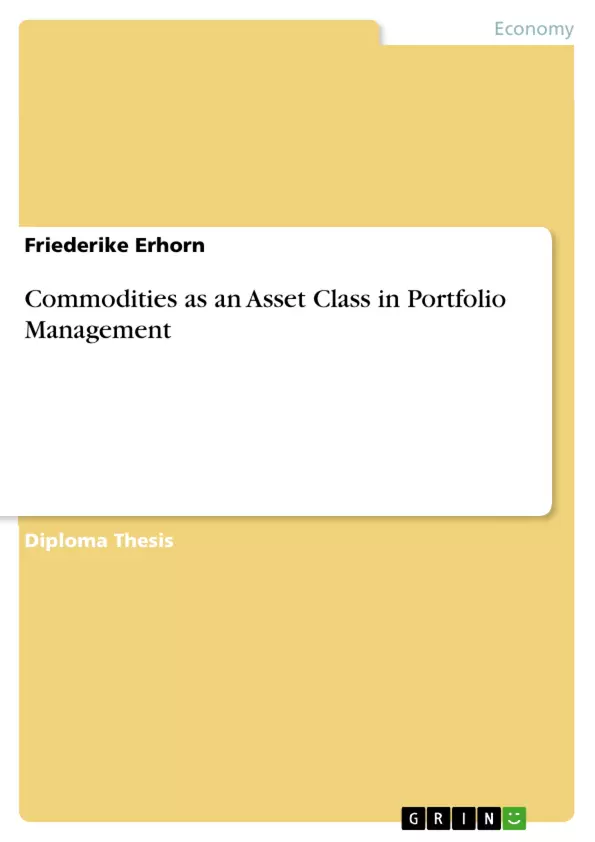Commodities have become an important tool in portfolio management strategies due to their good performance, the bullish outlook for this asset class over the next decade with commodity prices setting new highs and in contrast, the highly volatile performance of stocks and bonds as well as the major equity crashes in recent years.
This book analyses why and which commodities should be added to your portfolio. It gives a thorough introduction and analyses:
• Basic concepts of portfolio management and commodities
• Different investment exposures to commodities
• Return decomposition of commodity futures
• Evidence that commodities constitute an asset class
• Comparison of the different asset classes regarding risk, return and correlation as well as the performance analysis of the single asset classes with regard to the business cycle and inflation
• Efficient frontiers of portfolios with and without commodities over different periods of time
The key objective of this study is to investigate how commodities as an asset class influence the risk-return-ratio of a traditional portfolio in a passive investment strategy over various periods of time.
Table of Contents
- Introduction
- Problem Definition and Ambition
- Research Methodology
- Portfolio Management
- Basics of Portfolio Management
- Risk
- Return
- Modern Portfolio Theory
- Idea and Assumptions of Markowitz's Portfolio Selection Model
- Statistical Basics
- Efficient Frontier
- Capital Market Theory
- Capital Asset Pricing Model
- Capital Market Line and Market Portfolio
- Security Market Line
- Criticism
- Basics of Portfolio Management
- Commodities
- Commodities Definition
- Commodity Classes
- Energy
- Precious Metals
- Industrial Metals
- Agriculture
- Economics of Commodity Markets
- Commodity Futures Exchanges
- Driving Forces behind the Current Commodity Bull Market
- Market Participants
- Exposure to Commodities
- Futures
- Index Investments
- Stocks
- Funds
- Physical Commodities
- Criticism
- Investing in Commodity Futures Indices
- Mechanics of an Investment in Commodity Futures
- Relationship between Futures Prices and Spot Prices
- Backwardation and Contango
- Sources of Index Return
- Spot Return
- Roll Yield
- Collateral Yield
- Diversification and Rebalancing Return
- Commodity Futures Excess Returns
- Insurance Perspective in the Theory of Normal Backwardation
- Hedging Pressure Hypothesis
- Theory of Storage and Convenience Yield
- Weather Fear Premium
- Comparison of Commodity Indices
- Commodity Index Components
- Reuters/Jefferies CRB Index
- S&P GSCITM
- Dow Jones-AIG Commodity Index
- Deutsche Bank Liquid Commodity Index
- Rogers International Commodities Index
- Risk and Return Comparison
- Commodity Index Components
- Criticism
- Mechanics of an Investment in Commodity Futures
- Commodity Futures and Traditional Asset Classes in a Portfolio
- Context
- Commodity Futures vs. Traditional Asset Classes
- Evidence Supporting Commodity Futures as an Asset Class
- Traditional Assets: Equity and Bonds
- Comparison of Commodity Futures and Traditional Assets
- Risk and Return Comparison
- Asset Classes and the Business Cycle
- Correlation Between and Amongst Different Asset Classes
- Portfolio-Optimization with Commodity Futures
- Commodity Futures as an Inflation Hedge
- Commodity Futures and the Efficient Frontier
- Criticism
- Conclusion
- Résumé and Target Achievement
- Perspectives
Objectives and Key Themes
This work aims to analyze the role of commodities as an asset class in portfolio management. It examines the economic factors influencing commodity markets and explores the potential benefits and challenges of incorporating commodity futures into investment portfolios.
- The economic characteristics and investment opportunities presented by commodities.
- The relationship between commodity prices and traditional asset classes like stocks and bonds.
- The impact of commodities on portfolio diversification and risk management.
- The potential of commodities as an inflation hedge.
- The integration of commodity futures into portfolio optimization strategies.
Chapter Summaries
- The first chapter introduces the research topic, defining the problem and outlining the methodology used in the study.
- The second chapter provides an overview of portfolio management theory, covering concepts such as risk, return, Modern Portfolio Theory (MPT), and Capital Market Theory (CMT).
- Chapter three delves into the characteristics of commodities, discussing their definition, classification, economic factors influencing their markets, and various methods of gaining exposure to commodities.
- The fourth chapter focuses on investing in commodity futures indices, exploring the mechanics of such investments, sources of index returns, and various theories explaining potential excess returns.
- Chapter five examines the relationship between commodity futures and traditional asset classes within a portfolio context. It compares their risk and return profiles, analyzes their correlation, and assesses the potential benefits of including commodity futures for portfolio diversification and inflation hedging.
Keywords
This work focuses on the investment aspects of commodities, particularly their inclusion in portfolio management. The core concepts encompass risk, return, diversification, inflation hedging, portfolio optimization, commodity futures indices, and the relationship between commodity prices and traditional asset classes.
- Quote paper
- Friederike Erhorn (Author), 2008, Commodities as an Asset Class in Portfolio Management, Munich, GRIN Verlag, https://www.grin.com/document/170194



